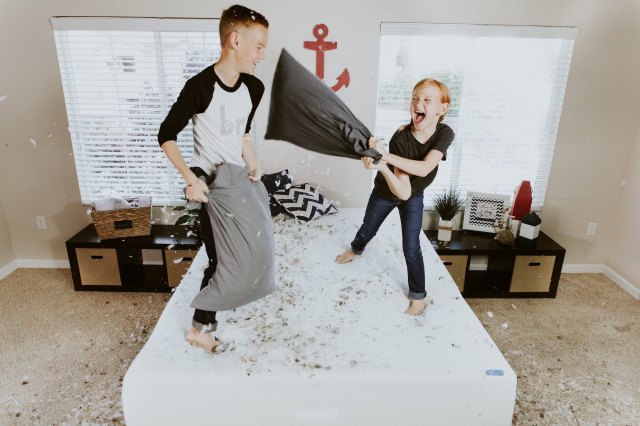Your child’s room should be their “safe” space. A sanctuary for them to escape to when needed, explore their imagination and feel comfortable and secure. As children get older, they seek more independence and control over their lives. Allowing your child to participate in the design and arrangement of their room can work wonders for their self-confidence and ability to make decisions.
Another challenge most parents face when it comes to room design is space! Finding furniture and design ideas that are both stylish and functional can be tricky. Here we explore some awesome ways to get your child involved in their room decor, without giving up complete control or needing to build an addition!
Let Them Choose the Theme
Like with any choice you give your child, limit the options. Present your child with two or three theme ideas and color schemes that you’re comfortable with. If you’re designing your son’s room, perhaps they’d find a sports or car theme cool. Is your daughter into princesses or even ladybugs or butterflies? All of these themes would make for a fun and creative bedroom space.
Your child can help pick the paint color for their new room also. Provide your child with a few different shades of the same color—a color that you could envision in the room for years to come. If they want blue, show them a light blue, darker blue and teal. Using this method allows you to control portions of the decision while still allowing your child to feel involved.
Save Space
There never seems to be enough room in a child’s bedroom. Between the bed, dresser, toys, clothes and other furniture, space is often a hard commodity to come by. But there are stylish solutions to this problem. Choose furniture that doubles as storage or use these unique ideas to get your children’s items off the floor.
Instead of adding a bookshelf that takes up additional space, you can opt for hanging book sleeves that are placed on any door in your child’s room. This way, they still have easy access to their favorite books, without crowding their room. Shelving on the walls is another great tip for small-space living. Your child can display their favorite dolls, model car or even store puzzles and games on low-hung shelves.
Don’t want your child’s toys cluttering the shelves or think they’re an eyesore? No problem! You can purchase a wide range of fashionable baskets and bins to store toys. These can be placed on shelves or under the bed. Together, you and your child can label these bins with pictures or words, depending on their age.
Pick a Focus
Did you know that some people design an entire room around a single piece of furniture? It’s true! And this can work beautifully for an older child. Help your son or daughter find a chair, bedspread or dresser that they love. Then, decorate and design around this piece.
If it’s a chair with a unique pattern, pull colors and inspiration from this. The same can be said for a trendy bedspread. My son recently chose a grey bedspread with red and black squares along the bottom. We paired it with red and black sheets, a grey area rug, and black hanging book holder for the back of his door. Look around your child’s room and you’ll be surprised at the inspiration you’ll find!
Use Bunk Beds or a Loft
Do you have siblings sharing a room? Two beds can take up a lot of space, not leaving room for much else. Bunk beds are a common and reliable option for siblings. There are countless modern designs that offer a new twist on a classic piece of furniture.
Just be sure to check your child’s bunk bed safety features. They’ll need a sturdy ladder for climbing. Encourage your child not to use the bed frame or rails to get to the top bunk—this can result in accidents and injury. Bunk beds come in a variety of designs. Some are equipped with drawers, storage and shelves. Choose one depending on your needs.
If you have the space and ability, building a loft in your child’s room is not only a great way to save space but it’s also a really neat sleeping arrangement for your child! Who wouldn’t want to climb a ladder to an isolated sleeping area? It’s like a permanent fort for your kid’s room. But just as with bunk beds, you’ll need to take appropriate safety measures when building a loft area for your child. Once the space is secured, your child can add countless things underneath the loft from a desk for doing homework to a cozy area decorated with oversized pillows or a bean bag chair.
Think Functionality-Meets-Style
Your child’s bedroom should be functional for their needs. If you’re designing a space for a younger child, you’ll want to consider toy storage and a fun theme. If your child is older, they’ll want to have more input in the bedroom design, and they can! Offer them limited options as far as paint color, furniture choices and wall decor.
Be sure to measure all furniture before adding it to the room. It’s also a good idea to sit with a piece of paper and furniture cut-outs. Use these to rearrange the furniture based on measurements. This way, you can see a multitude of design ideas before doing any heavy lifting.
Have fun with your child and let their creativity come through!











